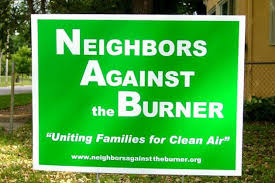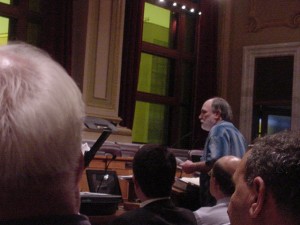NAB Petitions to Intervene in HERC Docket
September 26th, 2017

Yesterday Neighbors Against the Burner filed this Petition to Intervene in a docket at the PUC where Xcel Energy has filed a request for approval of a Power Purchase Agreement slashing the rate paid to Hennepin Energy Recovery Center – HERC for electricity generated at the HERC garbage burner:
Neighbors Against The Burner_Cover-Notice of Appearance -Petition to Intervene
Check out the Public Utilities Commission docket:
Click “Search Documents” HERE and search for docket 17-532
Here’s the Neighbors Against the Burner page for HERC:
And check out Alan Muller’s powerpoint from the successful challenge to attempt to increase garbage burning:
There was an announcement in April, 2016, of the “HERC Clean Power Plan Coalition” with multiple groups joining to shut down HERC! Sierra Club North Star Chapter, MPIRG, Neighborhoods Organizing for Change, Community Power, St. Joan of Arc, etc. HERC has been raised as an issue in this fall’s Minneapolis Mayoral election.
Now’s the time to get it done! SHUT IT DOWN!
GreenMark & Wacouta Township in Goodhue Co. District Court
September 12th, 2017

I found my notes!! On August 29, 2017, Alan and I went to the Goodhue County Courthouse for the GreenMark Solar v. Wacouta Township (Court Case No. 25-CV-17-1462) festivities — a Summary Judgment hearing.
FULL DISCLOSURE: I’m not a fan of any of the principals of GreenMark, Mark Andrew, Dennis Egan, and Julie Jorgensen. Mark Andrew is a former Hennepin County Commissioner and a fan of burning garbage. Here’s a thread from the Mpls yak-yak list about Andrew when he was running for Mayor. Dennis Egan, well, we had a few go rounds when he was Mayor of Red Wing AND was executive director of Minnesota Industrial Sand Council, and at the time silica sand mining issue was on agenda for City of Red Wing. Julie Jorgensen? Her Excelsior Energy Mesaba Project coal gasification plant took up 5 years of my full-time labor before it went to part-time and intermittent, and still just won’t fully go away! Minn. Stat. 216B.1694, Subd. 3(b)(1)(ii).
That said, I’m also a big fan of solar, from way, way back when my father designed the solar on the Minnesota Zoo (that was later taken down, it was hot water! Not quite what was most needed, and they didn’t know much about solar back then).
Here’s the GreenMark Complaint — couldn’t find the Wacouta Answer or the cross-motions for Summary Judgment. The Wacouta Township website is years out of date — what’s up with that? (2014 is most current minutes, plus a notice of the May 2017 meeting about the solar project. ???)
Here are a couple articles:
GreenMark Solar challenges Wacouta Township | Republican Eagle
Minnesota Developer Sues for Solar Garden Permit
The oral argument started with Greenmark. Some points (not all inclusive):
Focus on Minn. Stat. 394.33, Subd. 1, that the township decision violates Town Powers Act. It’s inconsistent with their zoning. They can enact more restrictive zoning, but they didn’t, township has no solar ordinance.2
Township ordinance is ambiguous. Frank’s Nursery case — if ambiguous, allow property owner to do what they want with the property.
“Agricultural community” — Planning Commission and Board selected different definitions. Current use, peat mining and hay. Pollinator scale 45, and 85 with solar. Wetlands. Reduce carbon emissions.
Township argument:
Town Power Act does not restrict township actions. Bergen defines inconsistent, it’s not different.
Township Ordinance, Art. 3, Subd. 10, limits industrial uses that do not support agricultural. Solar is an industrial use. Twp. does allow solar in ag, BUT, it’s more restrictive, and it’s not inconsistnet.
The standard is whether down decision was rational, i.e., legally sufficient, supported by record.
Reasonable — inconsistent with agriculture, exported to the grid. CUP – exported, GreenMark takes issue with def of ag use, but see “Hubbard Broadcasting” denial of Conditional Use. Review is deferential. Mandamus (GreenMark’s action) review not to challenge discretionary decisions of local government.
Frank’s Nursery re: ambiguous ordinance, doesn’t require ordinance to be construed to support use. Court still needs to determine rationality.
Greenmark Rebuttal
Mandamus – this is about building permit, a ministerial act, not discretionary.
Does township even have jurisdiction/authority.
Purpose of project — Goodhue County, that’s the area.
Altenberg (?) – Town Powers Act – Twp didn’t adopt a more restrictive ordinance.
Bergum (?) – legislative intent of Town Powers Act.
Township Rebuttal
Cases of Mandamus for building permits
Goodhue – zoned agricultural, township couldn’t zone industrial, that would be inconsistent with county zoning.
__________________________
Judge Bayley said he has a lot of homework to do, and will do it and issue Order.
Hiawatha Transmission Project MOES Recommendation
May 18th, 2011
Xcel Energy’s Hiawatha Transmission Project moves forward.
Recently, Comments and Reply Comments were due in this “informal” Certificate of Need proceeding. All the intervening parties in the routing docket have been sitting on their hands, or worse (I hope not, but why the silence?). So when only MOES filed “Comments” I filed Reply Comments, because theirs were SOOOOO… soooooo… well, read them yourself, they’re in INITIAL comments recommending that the Certificate of Need be approved, shouldn’t they at least make it look better by waiting to see what comes in before declaring that it should be approved?!?!?! … and the basis, well, it’s just absurd:
Here’s what I filed — I don’t have a dog in the fight, no client, no direct interest, but I cannot stand it when there’s NO response, NO filings, it’s just not right, and that’s when I get twitchy that somebody is pulling a fast one, and others did join in:
Johnson – Reply Comment Attachment
City of Minneapolis and Hennepin County Reply Comments
And then MOES has the last word, complaining that Xcel’s aren’t allowed under the PUC Rules of Practice in Minn. R. ch 7829!
A win! HERC denied permit by Mpls Planning Commission
June 23rd, 2009
WE WON A SMALL WIN — A START ON PREVENTION OF EXPANSION OF HENNEPIN COUNTY’S HERC BURNER!
Now and then, it sure helps to win, and Neighbors Against the Burner is on a roll here!
Here’s Alan Muller, testifying about specifics, noting that the areas of greatest concentration shown in the “ballpark EIS” were NOT in the ballpark, and the City has not addressed these impacts in any way:
In the meantime, here’s his letter to the Commission prior to the last meeting with a graph showing emissions:
Rep. Karen Clark came in to testify about her opposition to the project, citing the impacts of pollution on Hennepin County, armed with graphic graphics showing how bad the situation is already, and testified about specific impacts in her district, the Phillips neighborhood, particularly arsenic impacts, and other harmful pollutants.
Rep. Frank Hornstein also testified against the project, as did John Schatz, Leslie Davis, and the most bizarre HERC cheerleading twit, Mary deLaittre, who has actually written THIS (be sure to check the links.. “unique waste to energy facilities, oh pleeeeeze, pass the barf bag)– PARAGRAPH BELOW IS LINKED TO SITE:
- A HERCulean effort
- Because repetition is our friend, we feel the need to re-visit HERC (Hennepin Energy Recovery Center) and extol its virtues again. We sense that many have been missing the forest for the trees with respect to our pal HERC. HERC is a neighborhood amenity that provides an invaluable community service by disposing of 356,000 tons of garbage a year for Hennepin County. This garbage is converted into enough electricity to power 25,000 households, or 1/5 of all the residences in Minneapolis. Not only is it a 24/7/365 powerhouse, it is also a green building, to boot. Powerful as it is, HERC could do even more. HERC’s operators cite the plant’s unused capacity, and desire to contribute additional steam/water heating and cooling for the North Loop neighborhood. Like any building over 20 years old, it needs a bit of updating. A proposed makeover by Hennepin County and Covanta Energy, originally designed by students from the University of Minnesota, shows how the building and grounds could be transformed. So, as a city that touts itself as being green and wanting to be more sustainable, we should be celebrating HERC and supporting its efforts to become a better neighbor and community landmark. Visit our expanded collection of images featuring unique waste to energy facilities from around the world.
I’m speechless… too bizarre…
And alsoin the bizarre category, Asst. City Attorney wrote an opinion as to the City’s authority to adopt more stringent air emissions standards, a blatant attempt to quash their desire to act, to LAWFULLY act:
It was a hoot that he cited, offpoint, from Jimmy Jam Harris’ tax case in Hennepin County — when I looked that one up, right below it was Terry Lewis’ tax case! I can’t imagine why he’d cite these cases, as they didn’t make a useful argument for his view of statutory interpretation or lack thereof…
Anyway, I had a few minutes to blast off a reply:
From the article about it in the STrib, and note they’re clear about their authority:
Here’s the full article:




